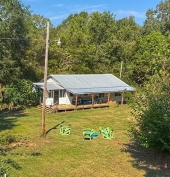I know this is a really broad question, but I thought I'd throw it out there to generate some discussion.
Short version - what would you do in the first year or three on 10 acres of raw land, to improve and prepare for some sort of eventual permie-style long-term system? Eventual meaning NOT looking to move there for a while. The biggest low-hanging fruit (bang for buck) due to limited time, ability, finance, etc.
Details:
I got 10 acres of a fairly gentle south slope. It's square and partially wooded, ponderosa pine and maybe a bit of doug-fir, It seems like it may have been logged a few decades back. From the little I've seen of Wheaton Labs on videos etc., I suspect this is fairly similar in general, less wooded though.
Obviously, I have a long-term project here. Someday I might put a wofati or something else on it. Maybe personal residence, maybe not; certainly at least a getaway / cabin / hunting lodge of some sort.
I dream of having a pond large enough to swim and play in (besides all the other usual pondy stuff, of course).
I am quite attracted by food forest concepts and would love to install some kind of long-term, mostly self-sustaining food crop system.
I don't have experience with animals but could see myself going there one day. Plus I realize they're an integral part of "natural" cycles, etc. There are a lot of deer in the area, probably elk too, and likely predators (cougars, maybe coyotes?).
I could see maybe keeping a small part in timber production, or something related like pollarding? At least for fuel, for market is lesser priority. And I know that a "wild" section is usual in permaculture, and I might....but it's almost next to a large state park with plenty of that.
This is ~45 minutes away from home so I won't be able to visit a whole lot at present (what with work, etc.). No utilities. In fact, no access per se yet either (my first project). Something like 25" of rain per year, zone 6ish. The generic area soil survey indicated it would make decent farmland, loess soils, high water table, perhaps 15/10/75 clay/sand/silt, 5% organic matter. (I have yet to verify any of that for my specific parcel.)
Given those kinds of conditions and fuzzy possible goals...... What would you do in, say, the first year?
The things I've thought of so far, feel free to add, subtract, multiply, divide, derive, integrate, correct, suggest, argue, etc:
Seed balls / bombs of various sorts - but what??
Cover crops?
Wildflower?
Perennial or self-seeding veggies, e.g. my radishes and kale and carrots have happily reproduced themselves with little effort on my part in the garden (although I did add water)
For that matter, my raspberries have been quite happy to reproduce.....hmm, I'll have to take some down there and let 'em loose

Start planting trees!
-What kind though? Nuts? Fruits?
Keep reading, learning what's possible, etc!
Work towards firming up some goals and desired end states.
In general....improve soils?
Let me know what you think!
TIA!!!

 2
2









 2
2




 3
3




 1
1





 1
1








 .
.
 1
1




 2
2




 2
2












 3
3





















